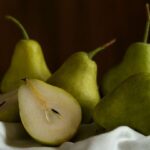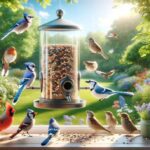Window bird feeders provide a unique way to connect with nature right from your home, making them a perfect addition to any bird lover’s summer routine. They offer an intimate view of various bird species, making it easier to observe their behaviors and appreciate their beauty up close. As we delve into the world of window bird feeding, we’ll explore the types of feeders available, how to attract a variety of birds, and the best practices for maintaining a clean and welcoming environment for our feathered friends.
1. Choosing the Right Feeder
The first step in setting up a window bird feeder is choosing the right type. There are several options available, each catering to different needs and preferences. Suction cup feeders, for instance, are excellent for close-up viewing as they attach directly to the window.
They come in various shapes, including platforms and tubes, and are typically made from durable materials like acrylic or polycarbonate for clear viewing and longevity.
When selecting a feeder, it’s also important to consider its ease of use – feeders with removable trays are easier to clean and refill. Additionally, you might want to consider feeders with features like drainage holes to keep seeds dry and roof overhangs to provide shade and shelter to birds.
- Type of Feeder: Opt for a feeder that attaches securely to your window. Suction cup feeders are popular for their stability and close viewing opportunities.
- Size and Capacity: Consider a feeder that can hold enough seed to last a few days but is not so large as to obstruct your view.
Consider products like the ‘Clear View Window Bird Feeder.’ This feeder attaches securely to your window with strong suction cups, providing an unobstructed view of birds. Another great option is the ‘Window Sill Bird Feeder,’ which extends outwards, accommodating larger birds and providing a more spacious feeding platform.
2. Selecting the Appropriate Seeds
The key to attracting a diverse range of birds is offering the right type of seeds. Black oil sunflower seeds are universally loved by birds like finches, cardinals, and nuthatches due to their high-fat content and easy-to-crack shells. For attracting finches, thistle or Nyjer seeds are the go-to choice.
If you’re looking to draw in cardinals, chickadees, and doves, safflower seeds are a great option. While pre-mixed seeds can attract a wide variety of birds, they often contain filler seeds like milo, which many birds don’t eat.
Opt for higher quality mixes or create your own blend based on the birds you want to attract. It’s also important to consider the placement of different seeds within the feeder, as some birds prefer feeding from specific levels.
- Seed Variety: Different birds prefer different seeds. Black oil sunflower seeds attract a wide variety of birds. Nyjer seeds are excellent for finches, while safflower seeds appeal to cardinals.
- No Waste Options: Opt for hulled seeds or seed mixes to minimize waste and mess.
For seed selection, consider brands like Wagner’s or Kaytee, known for their quality bird seeds. Wagner’s ‘Greatest Variety Blend‘ offers a mix that attracts a wide range of birds, while Kaytee’s Nyjer Seed is perfect for finches. For cardinals and larger birds, ‘Lyric Cardinal Premium Sunflower and Safflower Mix‘ is an excellent choice.
3. Feeder Placement
Correct feeder placement is crucial for attracting birds and ensuring their safety. Ideally, the bird feeder should be placed high enough to be out of reach of ground predators like cats but still visible to both you and the birds.
A common mistake is placing the feeder too close to windows, which can lead to bird collisions. To prevent this, place the feeder either directly on the window or more than 30 feet away. This reduces the chance of birds gaining enough momentum to harm themselves if they do fly into the window.
Additionally, consider the view from inside your house. Placing the feeder near frequently used rooms, like the living room or kitchen, allows for maximum enjoyment.
- Window Selection: Choose a window that you frequently pass by for maximum viewing pleasure. Ensure it’s away from busy streets to provide a safe environment for birds.
- Height Considerations: Place the feeder at a height where it’s visible to birds and safe from ground predators.
4. Maintaining the Feeder
Regular maintenance of the feeder is essential for the health of the birds and the longevity of the feeder. This involves cleaning the feeder every two weeks with a mild bleach solution to prevent the spread of diseases among birds.
The seed level should be monitored and refilled as needed, while wet or moldy seeds should be removed immediately. Summer heat can cause seeds to spoil faster, so it’s crucial to check the feeder more frequently during these months. A well-maintained feeder not only attracts more birds but also ensures their safety and well-being.
- Regular Cleaning: Clean the feeder every two weeks with mild soap and water to prevent the spread of diseases.
- Refilling Routine: Check and refill the feeder regularly, especially during peak bird activity times.
Consider using accessories like Sapphire Labs Feeder Fresh, a bird-safe product that keeps seeds dry and mold-free. For cleaning, Nature’s Way Bird Products Cleaning Brush is specifically designed for bird feeders.
5. Deterring Pests
While bird feeders are intended for birds, they can often attract unwanted visitors like squirrels and insects. To deter squirrels, consider using squirrel-proof feeders or baffles. These feeders are designed to close under the weight of a squirrel, preventing them from accessing the seeds.
Regularly cleaning up spilled seeds and using seed trays can also help reduce the attraction of rodents. Managing insects is another challenge; ant moats are an effective solution, creating a barrier that ants can’t cross. Keeping the feeder area clean is crucial in preventing pest infestations.
- Squirrel Deterrence: If squirrels are a problem, choose a feeder with squirrel-proof features.
- Avoid Seed Spillage: Regularly clean up any spilled seeds to prevent attracting rodents.
To deter squirrels, try the Brome Squirrel Buster Window Feeder, which is weight-adjustable to keep squirrels out. For insect control, Parasol Ant Moats can be a useful addition.
6. Creating an Inviting Environment
Apart from offering food, creating a bird-friendly environment around your window can significantly increase the variety and number of birds that visit your feeder. This includes providing a nearby water source, like a birdbath, for birds to drink and bathe. Planting native plants and shrubs around the feeding area offers natural food sources and shelter, making the environment more inviting.
- Water Source: Set up a birdbath nearby to provide birds with water for drinking and bathing.
- Planting Bird-Friendly Plants: Surround your feeder with native plants and flowers to provide natural shelter and additional food sources.
Enhance your bird-friendly environment with accessories like the Athena Garden Cast Stone Log Bird Bath for a water source. Additionally, ensuring a safe space for birds by keeping pets away and minimizing disturbances will encourage more birds to visit.
7. Enjoying Your Feathered Friends
Window bird feeders provide a fantastic opportunity for bird watching and photography. Keeping a bird guide or using a bird identification app can enhance your experience by helping you learn about the different species visiting your feeder.
For photography enthusiasts, a good camera with a zoom lens can capture detailed images of these beautiful creatures, like ‘The Nikon Coolpix P1000‘ with its superb zoom capabilities. Observing birds from such a close range offers a deeper understanding and appreciation of their behaviors and characteristics.
- Bird Identification: Keep a bird guide or app handy to identify and learn about the different species visiting your feeder.
- Photography: Use the opportunity to photograph the birds up close, a rewarding aspect of window feeders.
Equip yourself with a National Geographic Bird Guide for identification and a pair of ‘Celestron Nature DX Binoculars‘ for a closer look.
8. Educational Aspect
In addition to being a source of enjoyment, window bird feeders can be educational, especially for children. They provide a hands-on opportunity to learn about different bird species, their feeding habits, and the importance of environmental conservation.
For adults, it’s a way to relax and connect with nature, offering a peaceful break from the hustle and bustle of daily life.
9. Seasonal Considerations
During summer, special considerations are needed to ensure the health and safety of the birds. High temperatures can cause seeds to spoil quickly, so it’s important to change them more frequently and keep the feeder clean. Different bird species may visit during summer, requiring adjustments in seed types and feeder placement.
During summer, adjust your feeding practices. Use Kaytee Park No-Mess Blend to reduce waste and spoilage. Consider a feeder with a built-in water tray to provide birds with a hydration source.
Frequently Asked Questions (FAQs) about Window Bird Feeding
The types of birds attracted to your window feeder largely depend on your location and the seeds you offer. Common visitors include finches, cardinals, chickadees, nuthatches, and sparrows. Offering a variety of seeds will attract a wider range of species.
To prevent birds from colliding with your window, place the feeder either directly on the window or more than 30 feet away. You can also use window decals or screens to make the glass more visible to birds.
It’s recommended to clean your window bird feeder at least once every two weeks. More frequent cleaning may be necessary during hot, humid weather to prevent mold and bacteria growth.
Yes, if not maintained properly, window feeders can attract pests like squirrels and rodents. Using squirrel-proof feeders and cleaning up spilled seeds regularly can help minimize this issue.
It’s best to avoid feeding birds bread or kitchen scraps. These items don’t provide the necessary nutrition and can be harmful. Stick to quality bird seeds and nuts.
Choose a window that is visible to you for enjoyment but also safe for birds. Avoid busy areas where birds may be startled or disturbed. Also, consider the proximity to trees or shrubs for bird shelter.
Yes, window bird feeders can be used throughout the year. However, the type of seed offered and maintenance routine may change with the seasons.
To photograph birds without disturbing them, use a camera with a good zoom lens and take photos from a distance. Avoid sudden movements and keep a respectful distance.
Wrapping up: Connect with Nature from your Window
Setting up and maintaining a window bird feeder is a rewarding experience that brings the beauty and wonder of nature closer to home. By choosing the right feeder, offering a variety of seeds, and creating a welcoming environment, you can enjoy a summer filled with the sights and sounds of birds right from your window. Remember, a little effort in maintaining the feeder goes a long way in ensuring a healthy and safe environment for your feathered visitors.
Happy bird watching!



